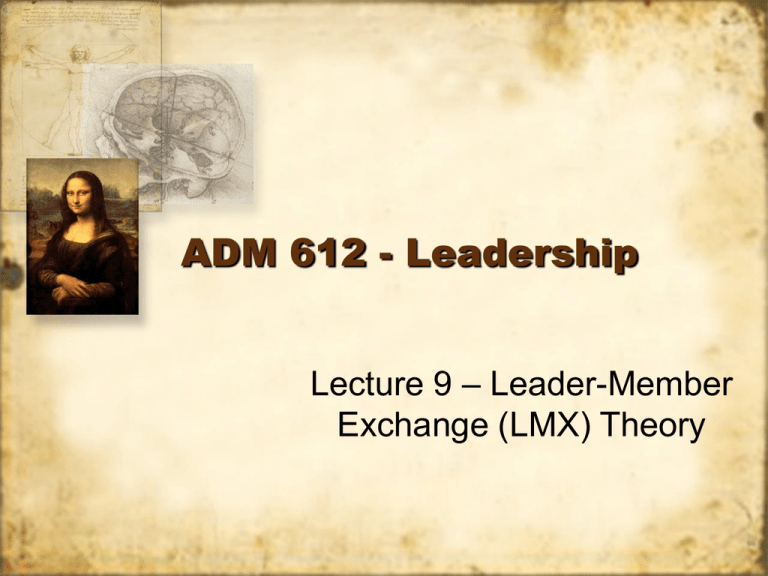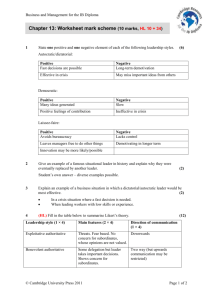PPA 577 & ADM 612
advertisement

ADM 612 - Leadership Lecture 9 – Leader-Member Exchange (LMX) Theory Introduction • • Most leadership theories emphasize leadership from the point of view of the leader (trait, skills, style) or the follower and the context (situational, contingency, pathgoal). Leader-member exchange (LMX) theory focuses on leadership as a process of interactions between leaders and followers. Introduction • • Older theories assume that leaders treated followers in a collective way using an average or group leadership style. LMX theory assumes that leaders interact with their followers individually. Early Studies • • • In examining the vertical linkages between leaders and followers, researchers found two basic patterns of linkages: In-group: based on expanded and negotiated role responsibilities (extra-roles). Out-group: based on the formal employment contract (defined roles). Early Studies • • Subordinates become a part of the ingroup or the out-group based on how well they work with the leader and how well the leader works with them. Personality and other personal characteristics play into this. Early Studies • • Also depends on how subordinates seek to expand their role responsibilities. Subordinates willing to negotiate with the leader to perform activities beyond their job description may join the in-group. Early Studies • • Subordinates not interested in new and different job responsibilities become part of the out-group. Subordinates in the in-group receive more information, influence, confidence and concern from their leaders than do outgroup subordinates. Early Studies • • In-group subordinates are also more dependable, more highly involved, and more communicative. Out-group subordinates are less compatible with the leader and tend to come to work, do their job, and go home. Early Studies Early Studies Early Studies Early Studies Later Studies • Later studies focused on how the quality of leadership exchanges influenced organizational effectiveness. Later Studies • High-quality leader-member exchanges produced less employee turnover, more positive performance evaluations, higher frequency of promotions, greater organizational commitment, more desirable work assignments, better job attitudes, more attention and support from the leader, greater participation, and faster career progress over 25 years. Leadership Making • How can exchanges between leaders and subordinates be used for “leadership making?” Leadership Making • Leadership making is a prescriptive approach to leadership that emphasizes that a leader should develop high-quality exchanges with all of her or his subordinates. “Make all employees part of the in-group.” Leadership Making Phases in Leadership Making • Stranger phase – Interactions rule-bound, relationships determined by role, lower quality exchanges. Subordinates concerned with self-interest. Phases in Leadership Making • Acquaintance phase. – Improved career-oriented social exchanges, assessment of additional role responsibilities, improved quality of exchanges, shift from self-interest to group interests. Phases in Leadership Making • Mature partnership. – High-quality leader-member exchanges, high degree of mutual trust, mutual interdependence, reciprocity, more egalitarian. How Does LMX Theory Work? • • It both describes and prescribes leadership. Important to recognize in-groups and out-groups in an organization. How Does LMX Theory Work? • • Working with in-group members increases organizational effectiveness. The prescriptive model urges leaders to develop high-quality exchanges with all subordinates. Strengths • • Strong descriptive theory – it makes sense to talk about in-groups and outgroups. Only theory to make use of dyadic relationship between leader and follower. Strengths • • Directs our attention to importance of communication in leadership. Empirical evidence to link high-quality exchanges to better organizational functioning. Criticisms • Descriptive LMX theory runs counter to basic understanding of human fairness. Focuses overwhelmingly on in-groups versus out-groups. Does not address other fairness issues (distributive, procedural, interactional). Criticisms • • The basic ideas of the theory are not fully developed. How do we initiate and maintain high quality exchanges? The measurement of leader-member exchanges not standardized. Application • • • • Directs managers to assess leadership from a relationship perspective. Can be use at all levels of an organization. Can be used to explain the development of leadership networks. Can be applied to different types of organizations.





